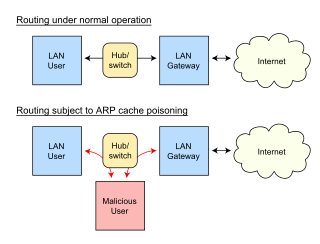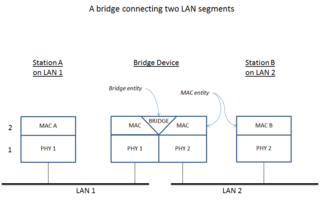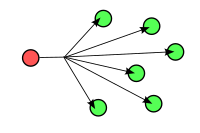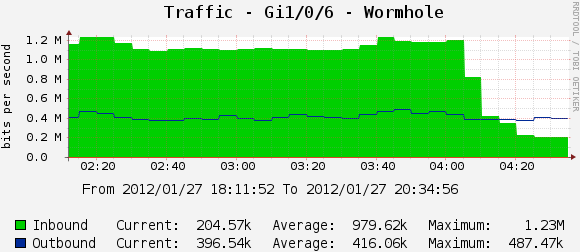A broadcast domain is a logical division of a computer network, in which all nodes can reach each other by broadcast at the data link layer. A broadcast domain can be within the same LAN segment or it can be bridged to other LAN segments.
The Spanning Tree Protocol (STP) is a network protocol that builds a loop-free logical topology for Ethernet networks. The basic function of STP is to prevent bridge loops and the broadcast radiation that results from them. Spanning tree also allows a network design to include backup links providing fault tolerance if an active link fails.
A virtual local area network (VLAN) is any broadcast domain that is partitioned and isolated in a computer network at the data link layer. In this context, virtual refers to a physical object recreated and altered by additional logic, within the local area network. Basically, a VLAN behaves like a virtual switch or network link that can share the same physical structure with other VLANs while staying logically separate from them. Between network devices, VLANs work by applying tags to network frames and handling these tags in networking systems – creating the appearance and functionality of network traffic that is physically on a single network but acts as if it is split between separate networks. In this way, VLANs can keep network applications separate despite being connected to the same physical network, and without requiring multiple sets of cabling and networking devices to be deployed.
A multilayer switch (MLS) is a computer networking device that switches on OSI layer 2 like an ordinary network switch and provides extra functions on higher OSI layers. The MLS was invented by engineers at Digital Equipment Corporation.

In computer networking, ARP spoofing, ARP cache poisoning, or ARP poison routing, is a technique by which an attacker sends (spoofed) Address Resolution Protocol (ARP) messages onto a local area network. Generally, the aim is to associate the attacker's MAC address with the IP address of another host, such as the default gateway, causing any traffic meant for that IP address to be sent to the attacker instead.
In computer networking, a media access control attack or MAC flooding is a technique employed to compromise the security of network switches. The attack works by forcing legitimate MAC table contents out of the switch and forcing a unicast flooding behavior potentially sending sensitive information to portions of the network where it is not normally intended to go.
The Multiple Spanning Tree Protocol (MSTP) and algorithm, provides both simple and full connectivity assigned to any given virtual LAN (VLAN) throughout a bridged local area network. MSTP uses bridge protocol data unit (BPDUs) to exchange information between spanning-tree compatible devices, to prevent loops in each Multiple Spanning Tree instance (MSTI) and in the common and internal spanning tree (CIST), by selecting active and blocked paths. This is done as well as in Spanning Tree Protocol (STP) without the need of manually enabling backup links and getting rid of switching loop danger.

A network bridge is a computer networking device that creates a single, aggregate network from multiple communication networks or network segments. This function is called network bridging. Bridging is distinct from routing. Routing allows multiple networks to communicate independently and yet remain separate, whereas bridging connects two separate networks as if they were a single network. In the OSI model, bridging is performed in the data link layer. If one or more segments of the bridged network are wireless, the device is known as a wireless bridge.
Network load balancing is the ability to balance traffic across two or more WAN links without using complex routing protocols like BGP.
Provider Backbone Bridge Traffic Engineering (PBB-TE) is a computer networking technology specified in IEEE 802.1Qay, an amendment to the IEEE 802.1Q standard. PBB-TE adapts Ethernet to carrier class transport networks. It is based on the layered VLAN tags and MAC-in-MAC encapsulation defined in IEEE 802.1ah, but it differs from PBB in eliminating flooding, dynamically created forwarding tables, and spanning tree protocols. Compared to PBB and its predecessors, PBB-TE behaves more predictably and its behavior can be more easily controlled by the network operator, at the expense of requiring up-front connection configuration at each bridge along a forwarding path. PBB-TE Operations, Administration, and Management (OAM) is usually based on IEEE 802.1ag. It was initially based on Nortel's Provider Backbone Transport (PBT).
A forwarding information base (FIB), also known as a forwarding table or MAC table, is most commonly used in network bridging, routing, and similar functions to find the proper output network interface controller to which the input interface should forward a packet. It is a dynamic table that maps MAC addresses to ports. It is the essential mechanism that separates network switches from Ethernet hubs. Content-addressable memory (CAM) is typically used to efficiently implement the FIB, thus it is sometimes called a CAM table.
Hierarchical VLAN (HVLAN) is a proposed Ethernet standard that extends the use of enterprise Ethernet VLAN (802.1Q) to carrier networks. A number of developments have emerged in recent years to help bring Ethernet, a flexible and cost-efficient packet transport technology, to carrier networks. These developments include Q-in-Q (802.1ad), PBB (802.1ah), PBT, and PBB-TE, which bring a set of features to traditional Ethernet to make it “carrier-grade”, adding to it high-availability, OA&M, and more.

Private VLAN, also known as port isolation, is a technique in computer networking where a VLAN contains switch ports that are restricted such that they can only communicate with a given uplink. The restricted ports are called private ports. Each private VLAN typically contains many private ports, and a single uplink. The uplink will typically be a port connected to a router, firewall, server, provider network, or similar central resource.
Data center bridging (DCB) is a set of enhancements to the Ethernet local area network communication protocol for use in data center environments, in particular for use with clustering and storage area networks.
IEEE 802.1aq is an amendment to the IEEE 802.1Q networking standard which adds support for Shortest Path Bridging (SPB). This technology is intended to simplify the creation and configuration of Ethernet networks while enabling multipath routing.
TRILL is an Internet Standard implemented by devices called TRILL switches. TRILL combines techniques from bridging and routing, and is the application of link-state routing to the VLAN-aware customer-bridging problem. Routing bridges (RBridges) are compatible with and can incrementally replace previous IEEE 802.1 customer bridges. TRILL Switches are also compatible with IPv4 and IPv6, routers and end systems. They are invisible to current IP routers, and like conventional routers, RBridges terminate the broadcast, unknown-unicast and multicast traffic of DIX Ethernet and the frames of IEEE 802.2 LLC including the bridge protocol data units of the Spanning Tree Protocol.
The link layer is the lowest layer in the TCP/IP model. It is also referred to as the network interface layer and mostly equivalent to the data link layer plus physical layer in OSI. This particular layer has several unique security vulnerabilities that can be exploited by a determined adversary.
Virtual Extensible LAN (VXLAN) is a network virtualization technology that attempts to address the scalability problems associated with large cloud computing deployments. It uses a VLAN-like encapsulation technique to encapsulate OSI layer 2 Ethernet frames within layer 4 UDP datagrams, using 4789 as the default IANA-assigned destination UDP port number, although many implementations that predate the IANA assignment use port 8472. VXLAN endpoints, which terminate VXLAN tunnels and may be either virtual or physical switch ports, are known as VXLAN tunnel endpoints (VTEPs).
Time-Sensitive Networking (TSN) is a set of standards under development by the Time-Sensitive Networking task group of the IEEE 802.1 working group. The TSN task group was formed in November 2012 by renaming the existing Audio Video Bridging Task Group and continuing its work. The name changed as a result of the extension of the working area of the standardization group. The standards define mechanisms for the time-sensitive transmission of data over deterministic Ethernet networks.

Broadcast, unknown-unicast and multicast traffic is network traffic transmitted using one of three methods of sending data link layer network traffic to a destination of which the sender does not know the network address. This is achieved by sending the network traffic to multiple destinations on an Ethernet network. As a concept related to computer networking, it includes three types of Ethernet modes: broadcast, unicast and multicast Ethernet. BUM traffic refers to that kind of network traffic that will be forwarded to multiple destinations or that cannot be addressed to the intended destination only.






